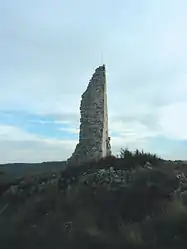Le Puy-Sainte-Réparade
Le Puy-Sainte-Réparade or Le Puy is a commune in the Bouches-du-Rhône department in southern France.
Le Puy-Sainte-Réparade | |
|---|---|
 La Quille | |
.svg.png.webp) Coat of arms | |
Location of Le Puy-Sainte-Réparade 
| |
 Le Puy-Sainte-Réparade  Le Puy-Sainte-Réparade | |
| Coordinates: 43°39′51″N 5°26′17″E | |
| Country | France |
| Region | Provence-Alpes-Côte d'Azur |
| Department | Bouches-du-Rhône |
| Arrondissement | Aix-en-Provence |
| Canton | Trets |
| Intercommunality | Aix-Marseille-Provence |
| Government | |
| • Mayor (2008–2014) | Jean-David Ciot |
| Area 1 | 46.29 km2 (17.87 sq mi) |
| Population (2017-01-01)[1] | 5,719 |
| • Density | 120/km2 (320/sq mi) |
| Time zone | UTC+01:00 (CET) |
| • Summer (DST) | UTC+02:00 (CEST) |
| INSEE/Postal code | 13080 /13610 |
| Elevation | 164–492 m (538–1,614 ft) (avg. 196 m or 643 ft) |
| 1 French Land Register data, which excludes lakes, ponds, glaciers > 1 km2 (0.386 sq mi or 247 acres) and river estuaries. | |
Geography
Le Puy-Sainte-Réparade is located 15 km (9.3 mi) North of Aix-en-Provence via the N96 and then the D561.
It is located between the ridges of the Trévaresse and the River Durance which marks the natural boundary between the Vaucluse and Bouches-du-Rhône départements. Opposite Le Puy, on the other bank of the river, is Pertuis in the South Luberon.
The village is surrounded by vine fields and agricultural land, with arable crops on the plain and the vines on the hills. There is a beautiful walk up to the Sainte Réparade chapel and, on arrival at the summit, there are panoramic views over the Durance plain, the Luberon and the Alpilles hills.
The nearby 450m hill La Quille or La Quiho, "the keel", has the ruins of the 8th-century fortress, destroyed in the 17th century .
History
Carved stones show that Le Puy was settled in prehistoric times. The Celto Ligures Salluviens left traces during the Iron Age and there was subsequent settlement by the Romans.
In the 11th century, the Archbishops of Aix who were lords of Puy built a fortified château and acquired neighbouring lands.
In 1155, Pons de Lubières bought his Puy estates from Hugues d'Eguilles.
In 1212, Gui de Fos bequeathed goods to the Archbishop and chapter .
In 1268, the chapter of Aix gave the church of Puy to the Archbishop Vicedominis.
Around 1510, Le Puy suffered the Plague.
The fortress of La Quiho has been taken several times, first by Raymond de Turenne in 1391. Then in 1578, during the wars of religion, it was besieged for nearly three months, and was captured on 7 January 1579 by the lieutenants of the Count of Carcès, Gaspard de Pontevès, chief seneschal of Provence. It was taken again in 1591 by the Duke of Savoy and was eventually destroyed in 1612 by order of the Parliament of Provence.
Administration
| Date of election | Identity | Capacity | |
|---|---|---|---|
| March 2001 | Jean-Pierre Bertrand | ||
| Previous years' data not yet known. | |||
Population
| Year | Pop. | ±% |
|---|---|---|
| 1962 | 2,497 | — |
| 1968 | 2,569 | +2.9% |
| 1975 | 2,859 | +11.3% |
| 1982 | 3,079 | +7.7% |
| 1990 | 4,414 | +43.4% |
| 1999 | 4,813 | +9.0% |
| 2008 | 5,276 | +9.6% |
Churches
Saint Réparade chapel 10th century or 11th century (restored in 1677, later in 1975). A procession to it takes place on the saint's feast day, 8 October.
Parish Church Sainte-Marie 18th century.
Vineyards
There are three in the area:
Miscellaneous
Puy derives from the Provençal word "Puech", meaning an isolated hill.
"Sainte Réparade" is probably a corruption of "Sainte Réparate", patron saint of the diocese of Nice, some of whose relics were removed in the 11th century to the parish church of "Saint Maurice of Puy" which later took the name "Chapelle Sainte Réparade". According to legend, Saint Réparade was a young girl martyred in Caesarea during the reign of the Emperor Decius by a Roman Proconsul. Her body was laid in a boat and blown by the breath of angels to the bay now known as the Baie des Anges in Nice.
References
- "Populations légales 2017". INSEE. Retrieved 6 January 2020.
External links (in French, unless otherwise indicated)
| Wikimedia Commons has media related to Le Puy-Sainte-Réparade. |